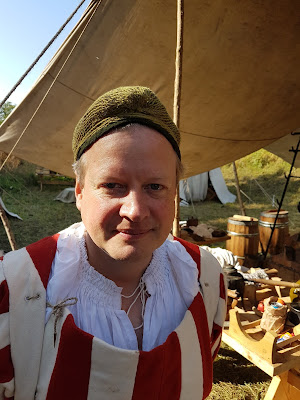In november 2020 I tried to make the big Tree of life sprang from Lengberg for the first time. I was, however, wrong in my assumption about the pattern and the sprang that I made was not according to the extant finds. That first try ended up though with me getting in contact with one in the team around the Lengberg finds, thank you R for not just getting annoyed with me...
She showed me pictures of the headwear, not available online, which helped a lot. I tried the pattern out again in late 2020 but it was to complicated for me and I lost track somewhere in the middle. I thought that I needed to do a little more sprang-training before trying it out again.
For you that does not heard of Lengberg here is a short background. During a restoration of the Lengberg castle (East Tyrol, Austria) in 2008 a filled vault was detected below the floorboards. More than 2,700 textile fragment were found in there. This part of the Lengberg castle was probably finished by 1485 so the finds is most likely predating this. Among the finds there were a couple of sprang woven fragments, in different conditions. They are all made of undyed linen z-spun s-plied two-ply thread. The largest one is still attached to the garment, a headwear, first thought to be a bra. It consist of four pieces of natural linen. In the middle, from the forehead to the back of the head, is a beautiful piece of sprang. It has a decorative patterns made up by holes. The sprang is 27 cm long.
The sprang pattern is that of a tree, the tree of life, and is repeated one and a half time. I assume that they had a pattern of the tree of life and needed to get to 27 cm for the piece to be long enough. So they worked it until they got 27 cm and that was one and a half time. But what do I/we know, maybe it was according to plane to use it one and a half time...
Anyhow, I have done a lot of sprang this past year and always got back to the big sprang of Lengberg in my mind. It was time, I was ready to try it out again. The pattern still scares me though...
The pattern comes from the article Enigmatic Beauty_Headwear of Lengberg castle. Carol James have made it from looking at the original piece. I dont have a printer so last time I was trying the pattern out I drew it from looking at the article on my computer.
Here is what it looks like. Scary!
The sprang patterns made by Carol are, in my opinion, easy to follow though the different turns of threads has different colours. The purple means two up one down, the orange means two up two down and the green means one up two down. So while working I dont need to count, I just look down and see a colour. The threads between the special turns still need to be counted though. So a row can start with a purple turn and then ten ordinary turns and than a green one, and orange one, a purle one, and than 18 ordinary ones. Maybe not the best explanation from my side...
I used a white linen two-ply thread made in Sweden. Where 100 grams is 420 meters (1377,95 ft). I wanted a little bit more than the 27 cm that is the original sprang. I tried that out and thought it was to short for my 57 head-size. I made a Lengberg cap out of the sprang with the wrong pattern last time and it came out really small. So I made this piece 31 cm.
This is probably the most difficult sprang pattern I worked with so far. Last time it was beyond my level. This time it worked out fine, even though I forgot to breath during the work...
I wanted to end up with a minimum of 30 cm long piece. With this yarn and the tension I managed I only repeated the pattern one time. But the tension look good, nothing wrong with it and its going to look so good on someones head.
And here is the result!

I will however, try to focus even more on the tension next time. It might be a little more me than the yarn. Even though the pattern still scares me I cant wait to put up another warp and do it again. I just need to make a couple of ordered hairnets before that.
While writing this, actually right about now, it hits me, the original was not white, it was undyed linen. How could I forgot that?! I need to buy more linen yarn... I would have thought that a pattern this complicated would have been made in a more expensive material than undyed linen. This is one reason this hobby is so interesting, you learn, all the time.
I already have a Lengberg cap, the small one, and I dont even do 15th century. This piece will be sold on etsy if anyone is interested.




















